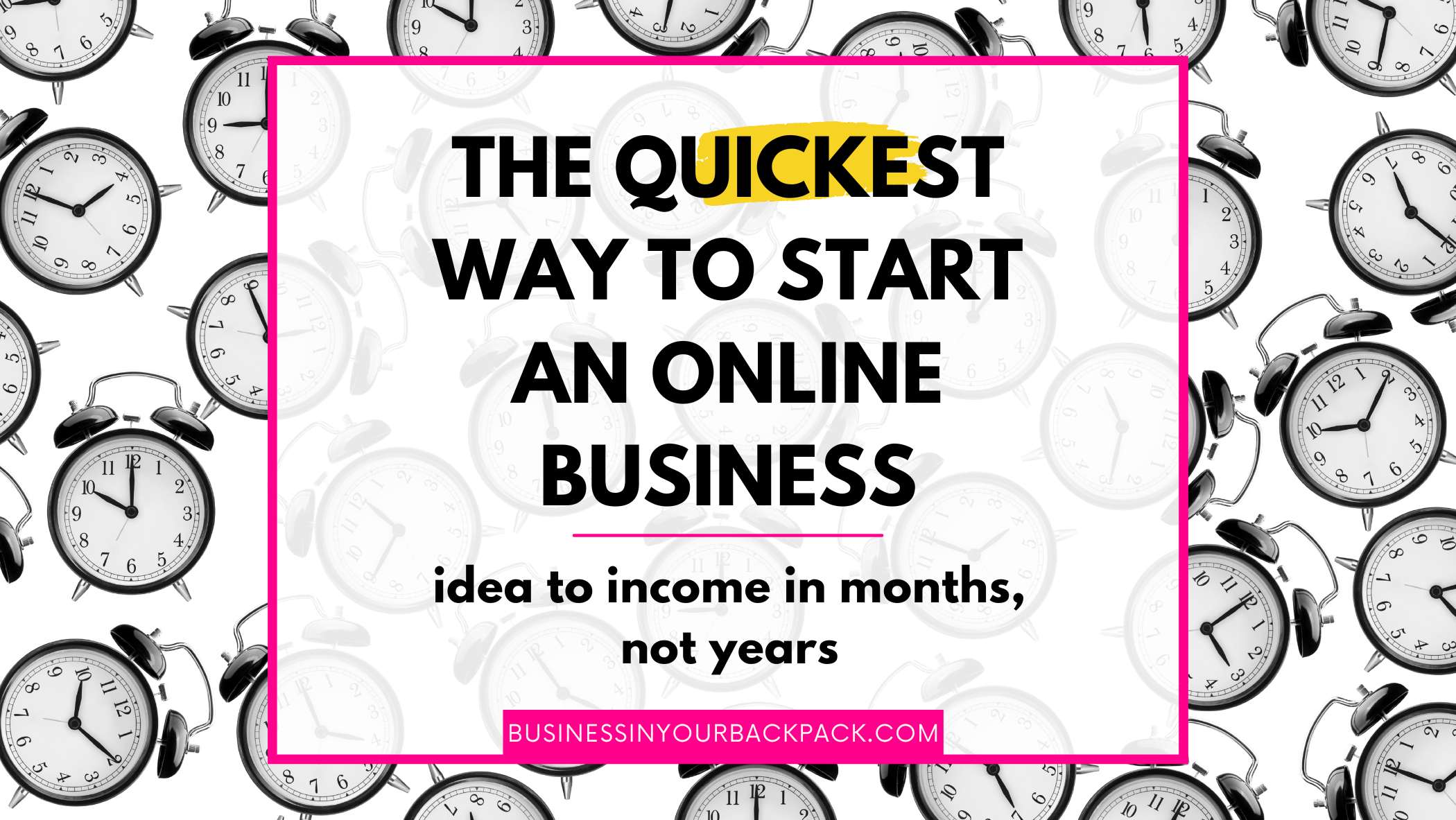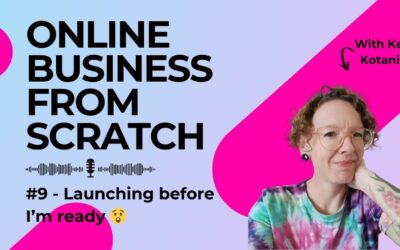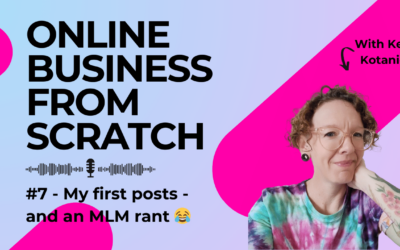So you want to start an online business.
You’re homeschooling, or want to be.
You’re travelling, or want to be.
Or you’re in another situation that means that out-of-the-home work isn’t a viable option for you.
So we need to reword that initial statement – you want to start an online business quickly.
You need something that will earn you money ASAP, because income is rather essential for life.
But you’re despairing because people tell you to expect that making money from your own business takes a ridiculously long time.
Like this comment in a ‘business advice for newbies’ thread.

I don’t know about you, but there’s no way I can mess around with an idea for FIVE YEARS without making decent money.
And barely earning anything for years is NOT putting myself and my family first. It’s impossible to live a good life if I’m stressing about how I’m going to pay the car rego.
(Also, note the unconscious belief there, that you can only get tiny bits done without neglecting yourself and your family. Untrue, and very unhelpful).
So this is your guide to the quickest way to start an online business.
A realistic, no-nonsense path to earning money from your skills and knowledge, quickly.
Note: by ‘online business’ I mean an independent business where you create and sell digital products, supplemented with affiliate income/ads if it suits you. Joining an MLM is NOT starting a business – don’t believe their hyped up promises.
Go through it step-by-step, and you’ll have a solid product tested by the end, and be ready to start making money with your online business.
Let’s go!
Table of Contents
1. Decide on your topic
First of all, you need to choose your topic.
If you want to get started quickly this needs to be something that you already know fairly well. Don’t just pick something you’re vaguely interested in and decide to teach it, especially in areas like health and mental health, where lack of knowledge can be harmful.
You don’t necessarily have to be an expert – here are a few different ways you can approach your content without pretending to know more than you do.
But you do need to have SOME knowledge and experience, and a strong interest in the topic.
Action steps
Do my free Business Idea Blitz mini-course.
It will walk you through brainstorming, narrowing down, then choosing your best online business topic in a few hours.
Seriously, it will be the best time you ever spend on your business – a clear topic is EVERYTHING.
You want examples of building an online business quickly? Of course you do!
I’ve created four people based on actual people I’ve worked with, and real businesses that exist.
You’re going to watch them set up their online businesses quickly, so you have a template to work with.
Examples
Annabel is a certified pilates teacher and has been the primary at-home parent and homemaker for 15 years. She’s been working in a studio teaching classes, but the pay is low. She’s realised that while she enjoys her work it’s getting boring, and she has a very low income ceiling. Plus she’d love to travel overseas, and their budget doesn’t allow for it right now.
Jim is a welder who abruptly became a stay at home dad. His two boys are neurodivergent and were struggling at school, and he and his wife agreed that the only real option left for them was homeschooling. Jim and his wife decided that Jim would quit his job to homeschool the boys. He’s been doing it for 6 months and the boys are thriving. But due to the rise in the cost of living, he’d really like to create an income for himself so they can actually reduce their mortgage, build some savings, and get ahead.
Joan has been working in childcare. She recently returned to work after having her first child, and her son goes to the childcare centre with her. However, he doesn’t sleep well so she’s often exhausted at work, and she finds herself resenting the time and effort she puts in with other children, when her own is in the next room but she feels like she barely sees him. Her partner earns barely enough money to cover the basics, so she can’t just quit. They’ve done the maths and she needs to earn at least $200 per week. She currently feels trapped and tired and desperate to find a solution.
Sarah works as a general hospital nurse, but she’s burnt out by the unpredictable shiftwork and a few toxic coworkers. She’s single, so she doesn’t have someone else to support her while she experiments. She has been living frugally and saving for a while, hoping that she can come up with a way to reduce her shifts or quit her job entirely. She loves the health industry, but knows she doesn’t have the depth of knowledge and experience to give direct health advice. She doesn’t know what else she can do.
2. Focus your topic
Now you’ve got your general idea, it’s time to niche it right down and get very specific about what you’ll be doing.
You will struggle with this.
Our instinct is to cast our net wide, to try to appeal to everyone.
But assume you’re a working parent who feels guilty that ‘brekky for dinner, everyone!’ has turned from a fun event into a regular rotation – which of the following ebooks would you buy?
- Quick and healthy meal plans for busy working parents
- Meal plans for everyone
How about another example?
You’re a mum with ADHD and your life is chaos. You need something to help you schedule and plan in a way that suits your neurotype – which would you choose?
- Planning with mums with ADHD – how to harness your strengths and combat your weaknesses so you never miss another appointment
- Day planning – how every woman can be organised every day
Of course you’d choose the one that is specifically suited to your situation. We all want to know that products have been specifically tailored to our personal problems.
So why would you choose to create the vague version?
You’ll get this result.

Instead, speak directly to YOUR people, and tell them you’ve got EXACTLY what they need.
THAT’S the sort of targeted product that people will buy without dithering, so it’s the product you want to sell.
Action steps
Narrowing down and getting specific is included in the Business Idea Blitz course – sign up if you haven’t already!
OK, let’s see what our imaginary people come up with.
Examples
Annabel knows she’s most comfortable working with people over 40, and that they trust her. Many of her students have confided in her about problems with their pelvic floor and core strength after having children, and the effects of perimenopause and menopause on their bodies. She decides to try focusing on fixing common issues for 40+ people.
Jim’s experience is all in welding. He’s only ever worked for big businesses but he enjoys tinkering in his shed. He likes to use scrap metal to make statues, decorations, and other quirky stuff. He decides he wants to find a way to make money from his creations.
Joan loves spending time outdoors, and found that the children in her centre thrived when outdoors, even though the childcare centre’s yard was small and not very natural. She naturally spends a lot of time outdoors with her son, something other parents have commented on wistfully. She’d love to focus on outdoor time, nature play and nature crafts for children under 5.
Sarah thinks about it for a while, and realises that her experience travel nursing could be useful to others. She spent a couple of years doing agency work, travelling all over the country, and other nurses often want to hear her stories and ask her questions about her experiences. She decides she’ll experiment with helping nurses become travel nurses.
3. Research time
Now it’s time to have a look at what’s already out there.
Do people already teach your specific thing? How do they do it? What do their offers include? How much do they charge?
There’s a good chance you’ll look around and feel discouraged. There will be people doing what you want to do or close to it. They may already have huge followings and polished websites and a full suite of offers.
You may even wonder if there’s room for you.
But it’s like cake.

The answer is nearly always yes, there’s room for more.
You may need to change your approach a little, or offer a slightly different service or service a different audience than the businesses that already exist.
You actually don’t need THAT many customers to make a good living.
This is simple maths – if you have 1000 fans who will pay you $100 per year, you have $100,000 in revenue.
So if you can think of something (or a range of somethings) that 1000 people would LOVE to have, you’ve got a profitable idea.
I also break this down into different income stream calculations in the Business Idea Blitz, so make sure you check out the bonus lesson.
Action steps
- Find THREE online businesses that cover your topic.
- Sign up to their email lists and social accounts.
- List the products they offer (a Google Doc or pen and paper is fine)
- Browse the sorts of sub-topics and issues they cover and address.
Can you see gaps in their information or products? Is there a part of that topic, or an audience, that they aren’t serving?
- Now, join related groups/communities about the topic. Scroll through and read the posts and comments.
Are there some problems and questions that crop up over and over again? What are the most common issues people interested in your topic have?
Examples
Annabel looks at pilates instructors. She also looks at yoga teachers, barre classes, and fitness studios to see what they’re offering people experiencing menopause.
She finds that most are quite general. Instructors with big followings may offer a ‘yoga for menopause’ class, and the public videos have very high view numbers, but no-one specialises in the topic.
Jim finds that videos about welding are very popular. Many sites seem to earn money with in-depth content, ads, and affiliate links. However, very few online welding businesses seem to have products. He doesn’t want to create endless content, so he starts thinking about how he can turn what he knows into products.
Joan looks at forest schools, playgroups, and unschoolers to see what they’re doing outside with their children. She finds there’s a big movement to help get children back in contact with nature, reduce their time on screens, and keep them healthy. She also finds that most parents struggle to find the time, and to know what to do when they do have the time. Many feel guilty because they know their preschoolers aren’t active enough. She realises there is a need, but she needs to make outdoors and nature the easy option.
Sarah finds that the bulk of information about travel nursing is produced by agencies, and nurses are wary of agency claims. Many have promoted great placements that have turned out to be too good to be true, and she’s fascinated by the horror stories she finds.
But there are plenty of nurses out there interested in travelling to different places, anything from an adventure for a few weeks every year to people who spend years in short-term placements, and she thinks they’d appreciated a trustworthy source of information.
4. Brainstorm your first product
Because a business isn’t a business without something to sell!
To start with, it doesn’t need to be big. It’s actually better if it’s small.
A small product is a great way to test the demand for your idea – do people actually want what you’re intending to sell? And will they pay for it?
You can create it and test it quickly, then polish it and launch it quickly.
And once you start growing your audience you’ll have invaluable feedback on bigger products you could create.
Action steps
What’s something small and simple that you could create to help people with their common problems and questions?
Outline what you’ll include, and keep it as targeted as possible. Don’t try to solve all their problems at once – just pick one small problem that you can fix quickly for people.
You should be able to sum it up what your product does and for who in one short sentence – I’ll include an example sentence with each of our theoretical businesses.
Examples
Annabel decides on a short online course about pelvic floor rehab. She’ll include specific exercises and workouts, with videos detailing how to do each exercise appropriately and why it’s useful. She’s noticed many people feel a sense of shame or embarrassment, so she’ll include lots of reassurance about how normal these problems are. She’ll also automate reminder emails and include recommended schedules that can be checked off, as another common problem for her audience is actually doing the exercises.
Sentence: This course teaches post-menopausal people how to strengthen and stabilise their pelvic floor with gentle exercises.
Jim does the maths on selling his creations. They take a long time to make, so like many handmade items he couldn’t make enough for a decent income. But he decides that he can teach people how to make each one with courses that include video and written instructions. He decides to narrow down the things he’s made to those that are relatively quick and small, and easy enough for amateur welders. This way he can create more of them more quickly, and welders of every level can feel confident enough to follow along.
Sentence: I teach home welders how to make quirky sculptures and artwork they can display, gift or sell, using mostly scrap metal.
Joan’s activities need to be short and straightforward due to her audience, and she know that selling them separately for a few dollars each wouldn’t create a decent income. She decides to start a low-cost membership where she’ll email out a nature-play fun list each week. Families will receive a short list of doable activities with instructions, and she will theme them according to seasons, holidays, and whatever else is relevant.
She creates a loose plan to start with 10 activities, and add two per week for the first 10 weeks. After that she’ll create one per week, and slowly build her content library. When she has a decent content library she can consider increasing the price.
Sentence: This membership helps parents and caregivers of preschool aged children spend fun and educational time outside, with minimal preparation time and equipment.
Sarah decides she can send a weekly paid newsletter out to subscribers with the best job opportunities of the week. She can also create content as her community asks for it – she’ll start with resume templates, a short 101 course on how to get started, and a guide to the absolutely necessary plus the nice-to-have qualifications and experience and the best way to get them.
Sentence: I help nurses become travel nurses, by helping them gain the skills and experience they need, plus choose rewarding and positive placements.
5. Testing your product idea
You’ve got a product idea – great!
But following on from step 4 – a business isn’t a business without willing customers.
Nothing beats actual feedback from real people, and you shouldn’t do any more than create the skeleton of an idea without it.
It’s very, very easy to come up with something that you think is a great idea, spend months creating it and fiddling with every last detail, then release it to zero interest.
But with feedback you’ll be creating what people actually need and want. You’ll be learning their problems, their struggles, and hearing their questions. All of this gives you better content that is incredibly valuable to people, which means they rave about you to everyone they meet and they keep coming back for more from you.
In other words, you’re creating your true fans.
So now you’re going to find people who are your target audience, who are willing to be your guinea pigs, and will give you honest and thoughtful feedback in exchange for some targeted help from you.
While you’re working directly with these wonderful people, you’re going to be paying attention to EVERYTHING.
What are their common problems? Where do they stumble? What new ideas do they give you?
This will help you refine and develop your product idea so it’s a perfect fit for its target audience.
Action steps
Where can you find the right people to work with?
If you’re already involved in your topic (you are, right?) you’ll be able to think of a few places.
- Family and friends
- Your workplace
- Social/hobby groups
- Online communities
Work out a suitable way to put together your idea and share it, and put it out there.
Examples
Annabel talks to the people in her classes, plus posts on social media – her own and local business and buy/sell/swap groups. She says she’s working on some new programs and is looking for people with specific needs to test them. She offers them at the price of $15 per hour for a series of four sessions, with a maximum of 3 people per session. She’s set up a nice landing page with the info using Podia’s free plan, and takes payments via cash or Paypal. Her employer offers her a studio for minimal rent, to be revised if she goes ahead with the business.
Jim puts up photos of his creations online in relevant communities and asks people to vote for their favourites. He also books a stall at a local market and takes them to sell, with the main goal of finding out which ones people admire the most. He asks everyone who stops to chat to add their email address to a simple paper form, so he can manually add them to his new email list.
Joan takes a few friends and their children on individual nature walks so that she can observe them and talk with them about what they want and their common problems. She then contacts local playgroups and asks them if she can run informal nature craft sessions for them. She collects people’s details for her email list. From this she’s tested out her first 10 craft ideas with real children. She also has a long list of problems she can help people solve, such as how to play outside if it’s raining, what to do when your child doesn’t like getting dirty, and nature play in cities. These would be great topics for free content to lead people to her membership.
Sarah offers 1:1 travel nursing career consults on online nursing communities. She develops a questionnaire to find out their background and goals, develops a roadmap for them, and then discusses it with them directly before sending them a personalised plan. She’ll offer 3 for free, then start charging a small amount, increasing as she gains experience.
Side note: Why charge?
You’ll note that most of our experimental people are charging money for testing.
Charging a small amount eliminates the people who will do anything that’s free, because they’re not your target audience. You want to learn from people who will actually pay to get your help.
And charging people helps to validate your idea – after all, the entire point of a business is for people to pay. If people will pay a small amount for your testing, it’s a good sign that they’ll pay more for a polished final product.
Finally, it’s incredibly confidence-boosting to have people pay, even if it’s not a sustainable price. That vote of confidence will keep you going when the work gets difficult.
Eek! What if no-one signs up/buys?
No problem – it happens to everyone.
And it’s why you’re testing your product ideas. You want to find out if people will actually buy it BEFORE you spend months and $$$ creating a final finished product.
So take what you’ve learned, go back to your list of ideas, talk to more people, and try to come up with an idea they’ll like more.
It might take you a few tries, but once you get it you’ll have an idea that WORKS. That’s worth a few knock-backs.
6. Use your testing feedback to create your business
You’ve got an idea that works, people are eager to pay for it – congratulations, you can start building it in earnest!
This will look different for everyone, but for an online business it will include the following.
- A website with your details
- Useful content that people can find
- A free resource to show what you can do and build your email list
- A way to sell your products
Yes, we’re FINALLY at the stage where you get to start your website! 🥳
It’s the task most people begin with, but really, if you don’t know what you’re going to put on it you’re wasting your time.
There’s no point obsessing over colour schemes or which hosting to use when you don’t actually have a clear vision and a plan.
You have that now, so you have my permission to begin.
But you also have my order to NOT get bogged down with it!
There are THOUSANDS of options to set yourself up online, but the best way I know for non-techies is Podia.
You can create a great-looking site, add products, and collect emails all in one platform.

It’s really quick and easy to set up, meaning you get to spend your limited time creating stuff to sell rather than solving tech issues.
And it’s free until you hit a certain level of growth, or want to add more advanced features.
Sign up for a free Podia account here, and get your site up today!
Quick note: All of our example people could run their online business solely with Podia, even though they have quite varied businesses. It really is that good.
What’s your idea?
Have you got all that?

That’s a LOT of info here, and it may take you a while to do it all, but if you take it step-by-step it’s very doable.
It will be tempting to just skip ahead to the part where you start a website, and to create your product all by yourself, but please don’t.
These are two of the biggest mistakes new online businesses make – but you know that now, so you don’t need to make them.
You can spend your limited time creating something that people actually want and need (and will pay for) and THEN market it, knowing that you can bring in income quickly.
So there you have it – the quickest way to start an online business that is sustainable, has a huge potential for growth, and a solid foundation.
So get to it! Sign up for the Business Idea Blitz and start your online business quickly, so you can have the freedom to live your life the way you need and choose.
And don’t forget to let me know your idea and your site in the comments – I’d love to see what you create.
Pin it for later






Thanks for another great post Kelly. It is such useful and actionable content. It goes really well with the business idea blitz course which was such a great resource.
I am not sure why my icon is a square blobby potato person but anyway, it made me laugh.
Haha, glad you like it! I get to choose the icon style for commenters who don’t have a profile pic, so of course I chose the most ridiculous one.
You’re very welcome!